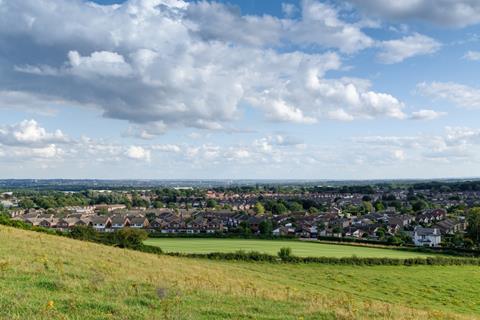Report by Carter Jonas looks at how much green belt land would need to be released to increase housing stock by 6%
Releasing less than 3% of green belt land in six regions of the UK would help deliver 300,000 homes per year, according to a report by consultancy Carter Jonas.

The report, ‘Rethinking the green belt’ identified that the “modest release of land” from the green belt forms part of the solution to addressing the urgent need for housing, either for edge-of-town development or along major transport arteries.
To build 300,000 homes per year over the next five years would mean delivering a 6% increase in the total housing stock.
In six regions, the South-east, North-west, North-east, East of England, West Midlands, and Yorkshire and the Humber, a 6% increase in housing would equate to using less than 3% of each region’s green belt land.
In London, achieving a 6% increase in housing over this period would require 21.1% of its green belt land to be used, assuming all new housing is constructed on it.
However, by delivering denser developments, the overall land requirement could be reduced.
>> See also: Government plans to limit landowner profits on green belt sales
>> See also: Why green belt development is sometimes the best
The report, published on 29 July, also said hat allowing more flexibility in the use of green belt land would simplify the local plan review process for authorities.
This would help avoid the “often lengthy” process of needing to change green belt boundaries during local plan reviews and enable more effective allocation of land.
David Churchill, partner at Carter Jonas, said: “Our research shows that housing need can be met without substantial loss to the green belt”.
He added: “We are not advocating all new homes being located on the green belt but are suggesting that there are strategic benefits in releasing some green belt land for housing.
“For example, it could reduce the number of ‘leapfrogging’ developments - those located further from urban areas than is desirable, which increase residents’ carbon footprints through extensive commutes and impacts on both businesses’ and residents’ proximity to urban centres.”
The report found that land designated as green belt extended to 1.6 million hectares in 2022/23, putting its coverage at its largest since 2004.
Department of levelling up, housing and communities (DLUHC) figures show that the amount of green belt land decreased by 20,000 hectares, from over 1.63m hectares in 2013/14 to just over 1.61m hectares seven years later (2020/21).
In the two years to April 2023, land designated as green belt increased by 25,443 hectares or +1.6%.
Over 10 years, to April 2023, only 39 local authorities have increased the extent of their green belt, while 102 have reduced theirs.
The property consultancy noted that most of the local authorities’ changes to designated green belt land have been minor.
Only three authorities expanded their green belt areas by 1% or more, while 13 authorities reduced theirs by at least 1%.
Northumberland County Council made the largest increase, expanding its green belt land by 61.5%, or 26,771 hectares.
In contrast, Central Bedfordshire released 1,284 hectares (a 4.6% reduction) of green belt land, after identifying these areas as being the most sustainable locations for development in the local plan review.











No comments yet